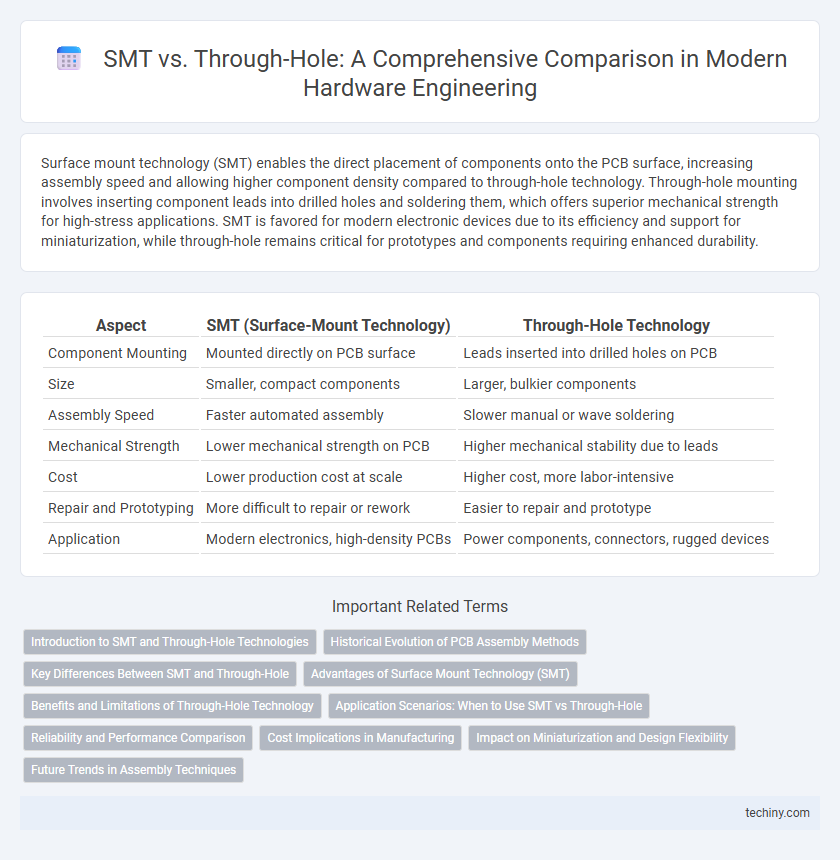Surface mount technology (SMT) enables the direct placement of components onto the PCB surface, increasing assembly speed and allowing higher component density compared to through-hole technology. Through-hole mounting involves inserting component leads into drilled holes and soldering them, which offers superior mechanical strength for high-stress applications. SMT is favored for modern electronic devices due to its efficiency and support for miniaturization, while through-hole remains critical for prototypes and components requiring enhanced durability.
Table of Comparison
| Aspect | SMT (Surface-Mount Technology) | Through-Hole Technology |
|---|---|---|
| Component Mounting | Mounted directly on PCB surface | Leads inserted into drilled holes on PCB |
| Size | Smaller, compact components | Larger, bulkier components |
| Assembly Speed | Faster automated assembly | Slower manual or wave soldering |
| Mechanical Strength | Lower mechanical strength on PCB | Higher mechanical stability due to leads |
| Cost | Lower production cost at scale | Higher cost, more labor-intensive |
| Repair and Prototyping | More difficult to repair or rework | Easier to repair and prototype |
| Application | Modern electronics, high-density PCBs | Power components, connectors, rugged devices |
Introduction to SMT and Through-Hole Technologies
Surface Mount Technology (SMT) enables components to be mounted directly onto the surface of printed circuit boards (PCBs), allowing for higher component density and automated assembly. Through-Hole Technology involves inserting component leads into drilled holes on the PCB and soldering them on the opposite side, providing stronger mechanical bonds ideal for high-stress applications. SMT is favored in modern electronics for its efficiency, whereas Through-Hole remains essential for components requiring durability and robust electrical connections.
Historical Evolution of PCB Assembly Methods
Surface-mount technology (SMT) emerged in the 1960s, revolutionizing PCB assembly by enabling smaller components and higher circuit densities compared to traditional through-hole technology, which relied on manually inserted leads through drilled holes. Through-hole methods dominated early electronics manufacturing due to their mechanical strength and ease of prototyping but became less efficient with the increasing complexity of modern circuits. The transition to SMT marked a pivotal evolution, enhancing automated assembly processes and supporting the miniaturization trends vital for advanced hardware engineering.
Key Differences Between SMT and Through-Hole
Surface Mount Technology (SMT) involves mounting components directly onto the surface of printed circuit boards (PCBs), offering higher component density and better performance at high frequencies. Through-Hole technology requires inserting component leads into drilled holes on the PCB and soldering them on the opposite side, providing stronger mechanical bonds ideal for heavy or high-stress components. SMT enables automated assembly and smaller PCB sizes, while Through-Hole is preferred for prototyping and applications requiring robust physical connections.
Advantages of Surface Mount Technology (SMT)
Surface Mount Technology (SMT) offers significant advantages, including smaller component sizes that allow higher circuit density and more compact device designs. SMT components enable faster assembly processes through automated placement and soldering, reducing manufacturing time and costs. Enhanced electrical performance and improved reliability result from shorter lead lengths and better mechanical connections in SMT compared to traditional through-hole mounting.
Benefits and Limitations of Through-Hole Technology
Through-hole technology offers robust mechanical bonds ideal for components exposed to mechanical stress, promoting durability in hardware engineering applications. Its ease of prototyping and manual assembly benefits low-volume production and repair scenarios, though it limits component density on printed circuit boards (PCBs). The primary limitation involves lower automation compatibility and larger PCB space requirements compared to surface-mount technology (SMT), impacting miniaturization and manufacturing speed.
Application Scenarios: When to Use SMT vs Through-Hole
Surface Mount Technology (SMT) is ideal for high-density electronic assemblies, such as smartphones and laptops, where miniaturization and automated production are critical. Through-hole technology excels in applications requiring strong mechanical bonds and durability, like automotive electronics, power supplies, and connectors subject to mechanical stress. Choosing between SMT and through-hole depends on factors such as component size, production volume, reliability requirements, and environmental conditions.
Reliability and Performance Comparison
Surface Mount Technology (SMT) offers higher reliability in electronic assemblies due to its smaller solder joints and better thermal cycling resistance compared to Through-Hole Technology, which is more prone to mechanical stress failures. SMT components enable higher performance by supporting greater circuit density and faster signal transmission, enhancing overall device efficiency. Through-Hole mounting remains advantageous in applications requiring superior mechanical strength and easier manual inspection, but SMT dominates modern hardware engineering for its reliability and compact design benefits.
Cost Implications in Manufacturing
Surface Mount Technology (SMT) significantly reduces manufacturing costs compared to Through-Hole technology by enabling higher component density and automated assembly processes, which decrease labor expenses and production time. Through-Hole components typically involve more manual handling and complex drilling steps, increasing material and labor costs. The reduced rework rates and material savings with SMT further contribute to lower overall manufacturing expenditures.
Impact on Miniaturization and Design Flexibility
Surface Mount Technology (SMT) significantly enhances miniaturization by allowing components to be placed directly onto the PCB surface, reducing board size and enabling higher component density compared to Through-Hole technology. SMT's smaller and lighter components increase design flexibility, supporting complex multi-layer PCBs and advanced circuit layouts that are impractical with Through-Hole mounting. Through-Hole, while offering strong mechanical bonds, limits compact designs and constrains advanced miniaturization efforts in modern hardware engineering.
Future Trends in Assembly Techniques
Surface mount technology (SMT) continues to dominate hardware engineering due to its compatibility with miniaturized components and automated high-speed assembly, driving advancements in multi-layer PCB designs and 5G hardware. Through-hole technology remains relevant for applications requiring strong mechanical bonds and higher power dissipation, especially in aerospace and automotive electronics where durability is critical. Future trends indicate increased adoption of hybrid assembly techniques combining SMT and through-hole for optimized performance alongside the integration of flexible PCBs and AI-driven process control to enhance precision and reduce defects.
SMT vs Through-Hole Infographic

 techiny.com
techiny.com